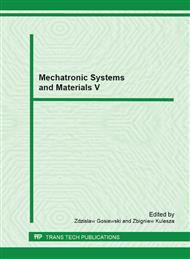[1]
Crockett R.: Boundary lubrication in natural articular joints. Tribology Letters 2009, Vol. 35, No. 3, p.77÷84.
DOI: 10.1007/s11249-009-9430-x
Google Scholar
[2]
Emge E., Karthikeyan S., Rigney D.A.: The effects of sliding velocity and sliding time on nanocrystalline tribolayer development and properties in copper. Wear 2009, Vol. 267, Issues 1-4, p.562÷567.
DOI: 10.1016/j.wear.2008.12.102
Google Scholar
[3]
Garkunov D. M. : Tribotechnology: Wear and No-wear. 4th ed. MAA Publishing House, Moscow 2001 (in Russian).
Google Scholar
[4]
Filip I.: Studies and researches concerning the tribological behaviour of friction couple functioning with selective transfer. Tribology International 2006, vol. 39, issue 8, p.774.
DOI: 10.1016/j.triboint.2005.07.006
Google Scholar
[5]
Hernándes Battez A. et al.: Wear prevention behaviour of nanoparticle suspension under axtreme pressure conditions. Wear 2007, Vol. 263, Issues 7-12, p.1568÷1574.
DOI: 10.1016/j.wear.2007.01.093
Google Scholar
[6]
Hernándes Battez A. et al.: CuO, ZrO2 and ZnO nanoparticles as antiwear additive in oil lubricants. Wear 2008, Vol. 265, Issues 3-4, p.422÷428.
DOI: 10.1016/j.wear.2007.11.013
Google Scholar
[7]
Kang X. et al.: Synthesis and tribological property study of oleic acid-modified copper sulfide nanoparticles. Wear 2007, Vol. 265, Issues 1-2, p.150÷154.
DOI: 10.1016/j.wear.2007.09.009
Google Scholar
[8]
Kotnarowski A.: Metal nanopowders as additives to lubricants. 2nd Vienna International Conference: Micro- and Nano-Technology. March 14-16, 2007, Vienna, Austria. Publisher: Österreichische Tribologische Gesellschaft, 2007, p.187.
Google Scholar
[9]
Kotnarowski A.: Metal nanopowders as additives to lubricants. In : Lubricants, Materials and Lubrication Engineering. Book of Synopses 2008. 16th International Colloquium Tribology, ed. Wilfried J. Bartz (Technische Akademie Esslingen, Ostfildern, 2008) p.209.
Google Scholar
[10]
Kotnarowski A.: Improvement of lubricants efficiency with metal nanoparticles addition. LUBMAT 2008 (LUBRICATION MANAGEMENT AND TECHNOLOGY 2008). San Sebastian, July 4-6, 2008. Lubrication Management and Technology – Full Scientific Proceedings. Edited by: Dr. Ana Aranzabe. Published by: Fundación TEKNIKER, Otaola, 20, 20600 Eibar, Spain. First edition 2008, p.30.
Google Scholar
[11]
Kotnarowski A.: Influence of nanoadditives on lubricants tribological properties. Materials Science 2008, vol. 14, No. 4, p.202÷208.
Google Scholar
[12]
Kotnarowski A.: Examination of Selective Transfer Phenomenon. Solid State Phenomena 2009, Vol. 144, p.279÷284.
DOI: 10.4028/www.scientific.net/ssp.144.279
Google Scholar
[13]
Kotnarowski A.: Selective Transfer Phenomenon in Copper-Steel Tribological Systems. Solid State Phenomena 2009, Volume 147-149, pp.558-563.
DOI: 10.4028/www.scientific.net/ssp.147-149.558
Google Scholar
[14]
Kotnarowski A.: Application of Metal Nanoparticles as Modifiers of Lubricants Tribological Behaviour. World Tribology Congress 2009, Kyoto, Japan. Proceedings of World Tribology Congress 2009, Sunday 6th to Friday 11th, September, 2009, Kyoto, Japan. Edited by: Japanese Society of Tribologists 2009, p.759.
Google Scholar
[15]
Kotnarowski A.: Generation of protective layers of copper and molybdenum nanoparticles in tribological processes. Monograph No. 136. Edited by Technical Univ. of Radom, 2009, 184 p.
Google Scholar
[16]
Kotnarowski A.: Selective Transfer Phenomenon in Friction Couples Lubricated with Base Oils. Solid State Phenomena 2010, Vol. 165, p.97÷103.
DOI: 10.4028/www.scientific.net/ssp.165.97
Google Scholar
[17]
Lee K. et al.: Understanding the role of nanoparticles in nano-oil lubrication. Tribology Letters 2009, Vol. 35, No. 2, p.127÷131.
Google Scholar
[18]
Ma J., Mo Y., Bai M.: Effect of Ag nanoparticles additive on the tribological behavior of multialkylated cyclopentanes (MACs). Wear 2009, Vol. 266, Issues 7-8, p.627÷631.
DOI: 10.1016/j.wear.2008.08.006
Google Scholar
[19]
Martin J.M., Ohmae N. (ed. ): Nanolubricants. John Wiley and Sons Ltd. 2008, 234 p.
Google Scholar
[20]
Padgurskas J., Snitka V.,. Jankauskas V,. Andriušis A: Selective transfer phenomenon in lubricated sliding surfaces with copper and its alloy coatings made by electro-pulse spraying. Wear 260 (2006), p.652.
DOI: 10.1016/j.wear.2005.03.033
Google Scholar
[21]
Polyakov A. A.: No wear due to friction based on coherent inter-action of dislocations and vacancies. No - wear Effect and Tribotechnologies, no. 1, 1992, p.13.
Google Scholar
[22]
Shpenkov G.P.: Energy and Resources Saving by New Multifunctional Addition Agent, Proceedings of 9th International Colloquium Tribology, Ecological and Economical Aspects of Tribology, Technische Akademie Esslingen, January 11-13, 1994, Ostfildern, Germany, 1994, p.11.
Google Scholar
[23]
Tarasov S. et al.: Study of friction reduction by nanocopper additives to motor oil. Wear 2002, Vol. 252, Issues 1-2, p.63÷69.
DOI: 10.1016/s0043-1648(01)00860-2
Google Scholar
[24]
Tarasov S., Belyaev S.: Alloying contact zones by metallic nanopowders in sliding wear. Wear 2004, Vol. 257, Issues 5-6, p.523÷530.
DOI: 10.1016/j.wear.2004.02.003
Google Scholar
[25]
Wu Y.Y., Tsui W.C., Liu T.C.: Experimental analysis of tribological properties of lubricating oils with nanoparticle additives. Wear 2007, Vol. 262, Issues 7-8, p.819÷825.
DOI: 10.1016/j.wear.2006.08.021
Google Scholar
[26]
Yu H. et al.: Research on the preparation and properties of Cu nanoparticles lubricant additive. Journal of Academy of Armored Force Engineering 2006, Vol. 20, Issue 5, p.86÷89.
Google Scholar
[27]
Zappone B. et al.: Molecular aspects of boundary lubrication by human lubricin: Effect of disulfide bonds and enzymatic digestion. Langmuir 2008, Vol. 24, Issue 4, p.1495÷1508.
DOI: 10.1021/la702383n
Google Scholar
[28]
Zhang M. et al.: Performance of anti-wear mechanism of CaCO3 nanoparticles as a green additive in poly-alpha-olefin. Tribology International 2009, Vol. 42, Issue 7, p.1029÷1039.
DOI: 10.1016/j.triboint.2009.02.012
Google Scholar


